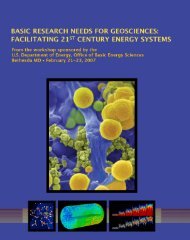Measurement Science Roadmap for Net-Zero Energy Buildings
Measurement Science Roadmap for Net-Zero Energy Buildings
Measurement Science Roadmap for Net-Zero Energy Buildings
- No tags were found...
Create successful ePaper yourself
Turn your PDF publications into a flip-book with our unique Google optimized e-Paper software.
V. WHOLE BUILDINGSThe Whole Building concept views the building as a system, rather than acollection of subsystems and components, and provides a broad, integratedperspective of overall building per<strong>for</strong>mance, including energy consumption.Viewing the building as a system allows full integration of energy managementand other building processes, enabling better overall building per<strong>for</strong>mance.This topic area focused on identifying the technologies and measurement scienceneeds relevant to a whole building energy indicator, assessment, and projection ofenergy per<strong>for</strong>mance including simulation models, intelligent design, systemsintegration, modeling and model validation, and other relevant systems and tools.Also addressed were indoor air quality control technologies that may enableenergy savings, such as heat-recovery ventilation, novel ventilation concepts, andapproaches to reducing outdoor air requirements, such as filtration, air cleaning,and low-emitting materials. Technologies applicable to both new and existingbuildings were considered. .A. Characteristics of the Future Built EnvironmentThe potential characteristics of future whole buildings are summarized in TableV-1. Anticipated designs of whole building concepts begin with greatercollaboration between the architects, engineers, and contractors in the planningphases. Ultimately, whole buildings will be designed with seamless integration ofcomponents into a single system that reduces energy consumption whilemaintaining occupant com<strong>for</strong>t and productivity.Whole Building DesignTable V‐1. Whole <strong>Buildings</strong> – Future Built Environment• Changes in the initial stage of design lead to more communication between architect, engineer, andcontractor.• Climate‐specific solutions are utilized to take advantage of the local environment; i.e., Denver offersdifferent opportunities than Miami• <strong>Buildings</strong> integrate passive cooling, cross‐ventilation, and alternative technologies• Different technologies work together to save energy while maintaining focus on human com<strong>for</strong>t andincreased satisfaction• Future per<strong>for</strong>mance metrics will focus on people, without needing to account <strong>for</strong> energyWhole Building Systems• <strong>Buildings</strong> per<strong>for</strong>m as designed without losses due to single malfunctioning components• <strong>Buildings</strong> are designed and operated to minimize source energy use and emissions• An energy‐producing building that goes beyond net‐zero can operate off the grid or provide surplusback to the grid• Occupants work efficiently, as the whole building meets telecommunication needs• Occupants can understand the energy implications of various decisions and actions36 <strong>Measurement</strong> <strong>Science</strong> <strong>for</strong> <strong>Net</strong>-<strong>Zero</strong> <strong>Energy</strong> <strong>Buildings</strong>
















